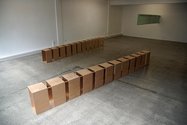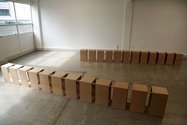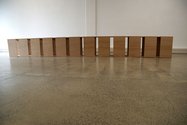John Hurrell – 8 September, 2015
In this elegantly understated show, a paper and glue ‘girder’ by Ian Peter Weston - projecting out from halfway up one wall - reaches towards two fragile looking ‘box kites’ (of light wood) by Oleg Polounine, positioned on the floor on the other side of the room. The three parallel works echo each other. With lots of space to walk around in, you circumnavigate the trio of linear sculptures, analysing their surfaces and forms, and the vertically of your own body’s position and movement.
All of these items are physically delicate. With Weston‘s contribution, an inspection up close means you can see an undulating rippled paper surface accentuated by glossy varnish over military green paint. The paper is thin, like taut skin stretched over armatures - but with patches, fold creases, occasional holes and overlapping seams.
Polounine‘s long rhythmical works on the other hand, seem to allude to Donald Judd’s modularly repeating sculptures, but on the floor they could also be two rows of stools - each seat being oblong in cross-section - even though they are obviously not designed to bear weight. Because of their kitelike associations (as if each sculpture were a series of twelve, spaced-apart, wrap-around bands) there is a paradox with their position being locked to the ground. The reverse is also true of Weston’s light-in-weight piece, which could from a distance be a heavy I-beam floating in the air.
As with earlier presentations at Snakepit, Antoinette Godkin and Allpress Gallery, Weston’s sculptures - despite their imposing interventionary spatial presence - are very much about paint and glued collage, and the viewer’s examining of paint surface and relief incident, not transparency or illusion. Presented on long horizontal planes, they have strange meandering titles that are like archaic elegiac poems (implying that Weston’s exhibited objects are metaphors or personal symbols), and use papered-over methods of suspension and tension/gravity control.
With Polounine, the ‘seating arrangement’ - not the title - becomes a metaphor or synecdoche where the twenty-four ‘stools’ can be interpreted as representing a conference or meeting. Maybe this is ‘the shift’ referred to in the title: a mental ideational shift that has resulted from discussion, and not the physical one that delivered and installed this project at RM.
So riffing on the title with a little speculation, perhaps that ‘shift’ is a consensus about say, Weston’s work, on the other side of the room - its interpretative possibilities, weighed up and assessed. There seems to be a detectable interaction between the two sets of work on both sides of the space. A back and forth energy; a commentary of sorts.
John Hurrell








 Advertising in this column
Advertising in this column Two Rooms presents a program of residencies and projects
Two Rooms presents a program of residencies and projects



This Discussion has 0 comments.
Comment
Participate
Register to Participate.
Sign in
Sign in to an existing account.